Light tank AAI RDF / LT (USA)
As design improvements and higher performance Tanks The Soviet Union and the United States became more complex and expensive. As a result, the creation of a fleet of equipment of the required size was associated with additional costs, which were the cause of numerous disputes. At the same time, the armies needed a lot of new equipment, which is why the issue of cost was especially acute. In the late seventies, the Pentagon proposed the development of new types of military vehicles with an acceptable ratio of cost and efficiency.
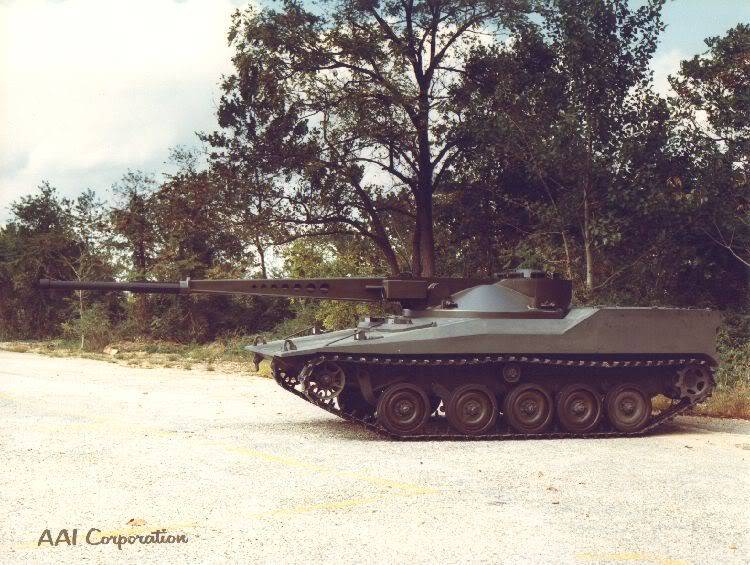
The prototype of the RDF / LT tank with the turret of the first version. Photo by Alternathistory.com
The prospective tank had to be distinguished by a relatively small combat mass, within 15-17 t. It was necessary to use existing or prospective guns with an optimal ratio of characteristics and cost. The design of the tank was required to apply the maximum possible number of mass-produced components and assemblies. The tank was to be distinguished by high mobility on the battlefield and to be able to be transported by existing aircraft. Fulfillment of such requirements allowed the army to get a cheap but effective light tank, with the ability to quickly transfer to the area of hostilities.
It was assumed that the solution of these tasks will significantly increase the combat effectiveness of the ground forces and tank units of the Marine Corps. In the event of the outbreak of a full-scale armed conflict, industry could as soon as possible launch mass production of new equipment, and military transport aviation would be able to quickly transfer tanks to Europe.
To work on the creation of promising armored vehicles attracted several defense industry companies. One of the participants of the program was the company AAI Corporation, which already had some experience in creating combat vehicles. The project from AAI received the working title of RDF / LT - Rapid Deployment Force / Light Tank (“Rapid Deployment Forces / Light Tank”). Other designations of the prospective car were not assigned. The traditional name for American armored vehicles with the letter “M” did not appear.
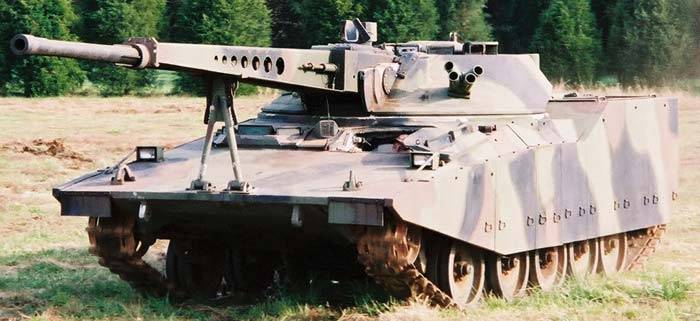
Tank with a tower of the second type. Photos Krasfun.ru
Requirements made by the customer led to the formation of the original appearance of a promising armored vehicles. It was proposed to use the existing experience in the creation of combat vehicles, but to adjust the basic ideas in accordance with the terms of reference. Thus, the design of the tank had to combine simplicity, cheapness and acceptable performance. In addition, it was planned to use the units of the existing serial machines. The main “donors” of the components are the light amphibious tank M551 Sheridan and the armored personnel carrier M113. Both machines were actively exploited by the US military, which could to some extent simplify the creation and use of new technology.
Despite the relative complexity of the tasks, AAI quickly completed the design. The design documentation for the RDF / LT tank was prepared in the summer of 1980, and in October the first prototype of the new machine was presented to the customer. Subsequently, the prototype was brought to the test, the results of which carried out the refinement and refinement of the existing structure.
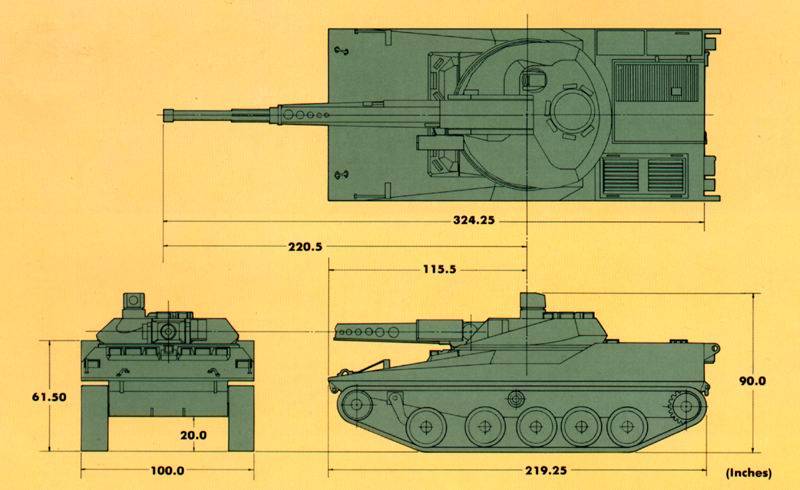
Scheme of a tank with a tower of the second type. Photo Btvt.narod.ru
Requirements to reduce the combat weight imposed certain restrictions on the design of the tank. In particular, they did not allow the use of a relatively powerful reservation, characterized by a corresponding weight. However, the issue of crew protection was resolved with the fulfillment of all existing requirements. The hull and turret of the tank were to be made of aluminum armor with steel inserts. In terms of protection characteristics, the RDF / LT tank hull had to match the M2 Bradley infantry fighting vehicle. Provided vserakursnaya protection against small arms and debris. Frontal projection could protect against small-caliber artillery. Protection against powerful tank guns were supposed to be low visibility and high mobility.
The RDF / LT tank received a hull of a characteristic shape capable of providing the greatest possible protection with a minimum mass. The frontal projection of the hull was protected by two inclined sheets forming a wedge-shaped structure. Both the upper and lower front sheets were placed at a large angle to the horizontal, which increased their reduced thickness. On the upper frontal sheet accounted for about a third of the total body length. Behind it was a horizontal roof plate with a shoulder strap for installing the tower. Aft roof was raised above the center because of the need to accommodate large units of the power plant. The tank received the board, consisting of several parts. Thus, in the frontal and central parts of the body, vertical sides of a small height were used, connected to the roof with inclined parts. The aft compartment received higher side plates. Available sides could be complemented by screens of great height.
The tank was built according to the traditional scheme, but the layout was finalized in accordance with the specifications of the technical specifications and the ideas applied. The front of the hull accommodates a double compartment control. The central compartment was given under the fighting compartment, and the feed was intended for the power plant and transmission.
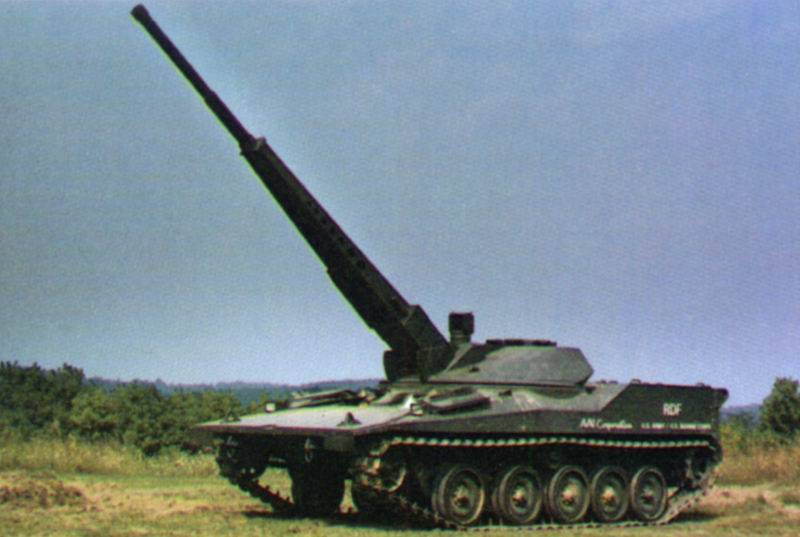
In theory, a tank could attack aerial targets. Photo Btvt.narod.ru
To reduce the size of the frontal projection in the project RDF / LT was proposed tower of the original design, characterized by reduced dimensions. Its base was a cast dome with a frontal part littered back. At its center there was an embrasure for mounting the rocking artillery unit, with the trunnions partially located outside the dome and placed on the respective vertical sheets. In the aft part of the tower, which has a semicircular shape in plan, was the workplace of one of the crew members. An alternative tower was also developed. The basis of this design was a hemispherical dome with an embrasure in the frontal part and a superstructure-turret in the stern. Having a different form, such a tower could contain all the same devices and devices as the product of the first type.
It was proposed to install a Detroit Diesel 6V53T hp diesel engine in the aft hull compartment of the hull. There were also fuel tanks with a capacity of 350 gallons (100 l). The car received a hydromechanical automatic transmission Allison X378. To facilitate the maintenance and repair of the engine and transmission were combined into a power unit. To perform certain operations, the power unit could be moved out of the aft compartment. It also facilitated the replacement of failed units: if necessary, it was possible to change the entire unit at once.
The tank received the undercarriage on the basis of five dual rubberized road wheels on each side. Used individual torsion suspension. Due to the specific shape of the frontal part of the body, the armored vehicle received increased balancers of the front pair of rollers: the torsion of the L-shaped part was approximately at the level of the axis of the front guide wheel and equipped with an additional shock absorber. All other rollers had a suspension of traditional design. In addition, the first between the first three pairs of rollers had an extended gap. Drive wheels placed in the stern. A small support roller was placed above the third track roller. Details of the M551 armored vehicle were used in the undercarriage of the light tank. The caterpillar was borrowed without significant changes from the M113 armored personnel carrier.
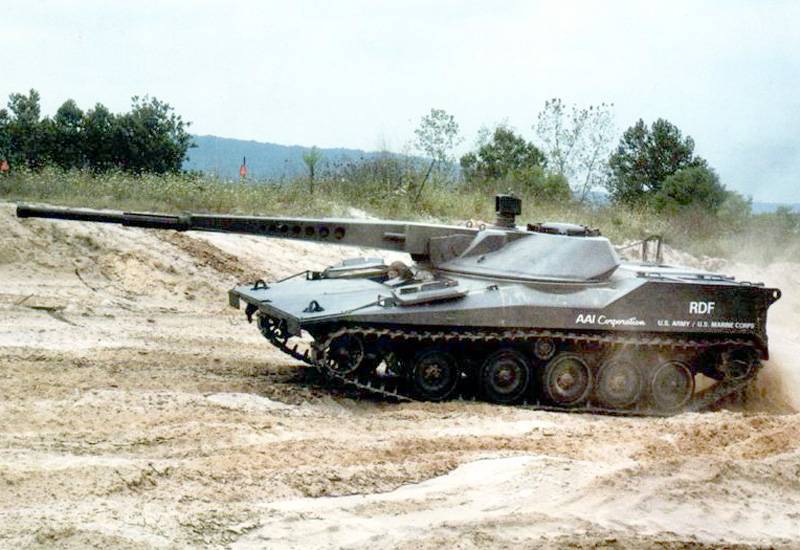
Experienced RDF / LT at the site. Photo Militaryfactory.com
As the main weapon for the RDF / LT light tank, the 75-mm gun of high ballistics ХМ274 ARES was chosen, which provides an increased initial velocity of the projectile. This gun was developed as the main weapon for promising light-class armored vehicles. Differing from other systems of a larger caliber in reduced combat qualities, such a gun should have been able to effectively combat other types of targets. Long-barreled gun mounted on a swinging base in the frontal part of the tower. At the same time, the breech of the gun with some of its mechanisms was located inside the rectangular casing-mask. Before such a mask there was an additional casing with perforation. The original design of the tower with a partly placed placement of the gun made it possible to change the angle of elevation from -15 ° to + 40 °. The latter gave certain possibilities in the context of the fight against air targets.
In the framework of the RDF / LT project, AAI developed new models of unitary 75-mm projectiles. To reduce the size of the shot and a corresponding increase in ammunition was proposed to use a telescopic scheme. In such a shot, the projectile is fully sunk into the liner, which gives a certain gain in size. According to this scheme, new high-explosive and armor-piercing sub-caliber shells were built. Inside the fighting compartment of a light tank, we managed to place the styling on 60 shots.
To save space inside the fighting compartment, reduce the mass of the vehicle and reduce the crew’s crew, they decided to equip the tank with an automatic loader. This device, at the command of the gunner, was to independently extract from the mechanized stacking a shot of the desired type and send it to the cannon of the gun. It should be noted that the design of the automatic loader allowed not only to exclude human participation, but also significantly increase the firepower of the tank. Mechanisms of the fighting compartment provided a rate of fire at the level of 70 shots per minute.
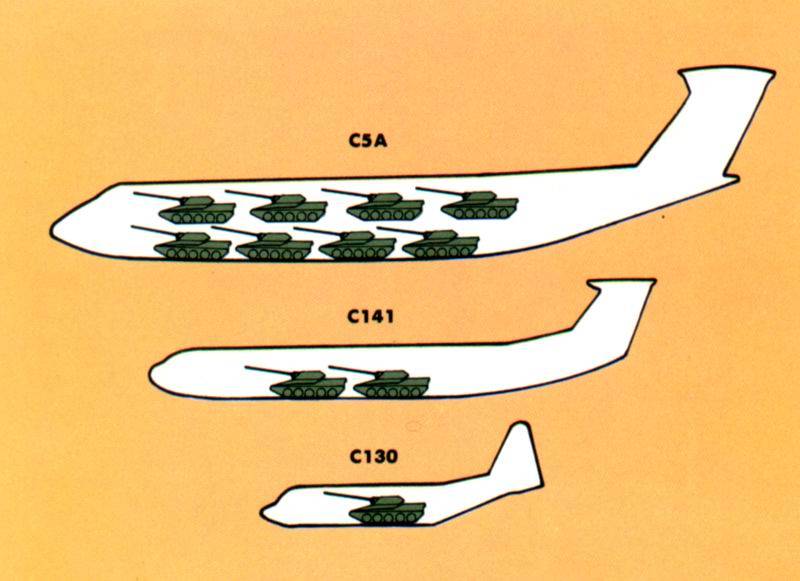
Options for loading armored vehicles in military transport aircraft. Photo Btvt.narod.ru
The caliber 75 mm imposed certain restrictions on the firepower, but the ARES gun still had the ability to effectively deal with various potential enemy armored vehicles. 75-mm projectiles with no problems could hit light armored vehicles. The tanks of outdated models were also not a complex goal. Modern main tanks with a powerful combined armored frontal projection could be hit only in the side or stern.
As an additional weapon, the RDF / LT tank could carry two 7.62-mm machine guns M240 and smoke grenade launchers. A machine gun paired with a gun was placed inside an armored mask, an anti-aircraft gun was placed on the roof of a tower. Smoke grenade launchers also located on the tower as part of two separated sets. The ammunition of machine guns was determined in 2600 cartridges, grenade launchers - 16 shots.
In the initial project, AAI offered the use of a developed complex of onboard optoelectronic and computing equipment necessary to enhance the firing characteristics. On the roof of the tower was proposed to place a rotary casing with a set of different optical systems. There could be placed day and night sight, as well as a laser rangefinder. Data from the sight, weather sensors, etc. came to the digital fire control devices. The latter controlled the work of guidance systems and a two-plane stabilizer. To output the video signal, screens were used at the gunner’s and commander’s workplaces. In the future, it was not possible to change the composition of the SLA and the sighting system in accordance with the wishes of the customer.
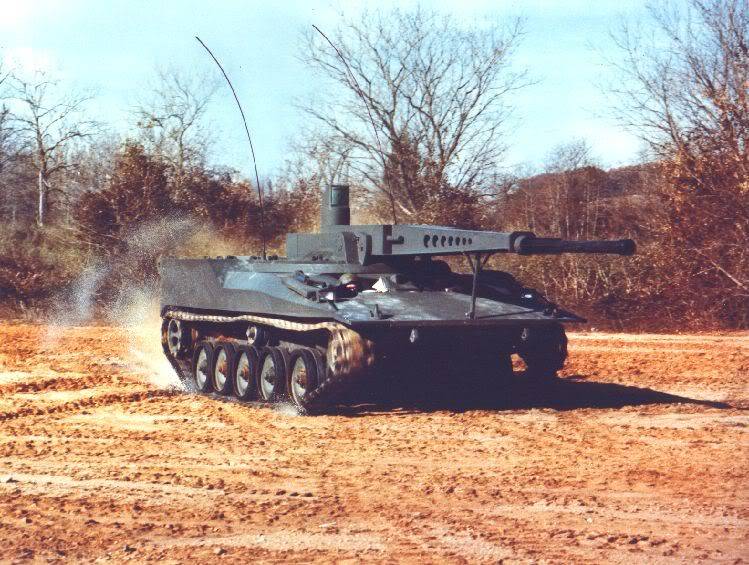
Tank with turret layout. Photo by Alternathistory.com
The crew of the RDF / LT consisted of three people. The driver and commander were in front of the hull and had their own hatches with optics. Workplace gunner placed in the stern of the tower under the hatch in the roof. Having a complete set of tower armament controls, the gunner could search and identify targets, as well as fire on them. In addition, the duties of the gunner included the use of anti-aircraft machine gun.
The prospective lightweight tank of a “simplified design” had a hull of length 5,6 m, (length with a forward cannon - 8,2 m), width 2,5 m and height all 2,2 m. The combat weight was 14,8 t. Specific power exceeded 23,6 hp per ton. The speed on the highway reached 65 km / h, the power reserve - 480 km. Without preparation, the tank is able to overcome the ford with a depth of about 1 m.
Due to its small size and weight, the RDF / LT tank could be transported by almost all United States military transport aircraft. So, the C-130 could take on one armored vehicle, the C-141 - two. By installing an additional deck, the C-5A could immediately carry up to eight tanks, four on each “floor” of the cargo compartment. Also, tanks could be transported by transport vessels, in which case transport could take on board up to several dozen armored vehicles.
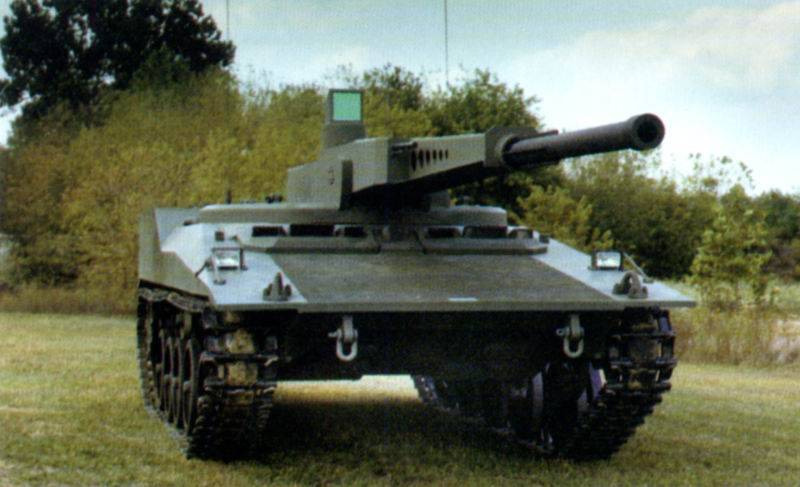
The new tower has reduced the size of the frontal projection. Photo Btvt.narod.ru
The first prototype of the AAI Rapid Deployment Force / Light Tank was introduced in October 1980. The car was sent for tests, during which the real characteristics of mobility and firepower were determined. It should be noted that in the course of the test program, an experienced tank was refined several times, including the replacement of existing units. So, initially the tank carried a tower with a hemispherical dome. In the future, it was replaced by a new unit using inclined front sheets. Later they performed another replacement of the tower in order to test some new ideas.
Of particular interest are the later modifications of the tower, built on the monitor layout. Instead of a full-fledged tower on the chase of the hull, a round platform was mounted with mounts for a rocking gun mount. At the last stand was located with opto-electronic devices. The entire crew was inside the hull. According to some reports, when developing such a tower, it was decided to abandon the gunner, transferring his functions to the commander. The latter was still in the front compartment of the corps and had to control the combat module using remote control systems.
Initially, the turret tower carried only a gun HM274 ARES in its own armored corps. Later it was supplemented with rocket armament. It was proposed to mount two rectangular armored launchers M6 Linebacker with four guides for anti-aircraft missiles on each side of the gun unit. Pre-targeting of rockets in the horizontal plane was to be carried out by turning the entire turret, vertical - with the help of hydraulics, synchronized with the gun drives. In this configuration, the tank could fight both ground and air targets.
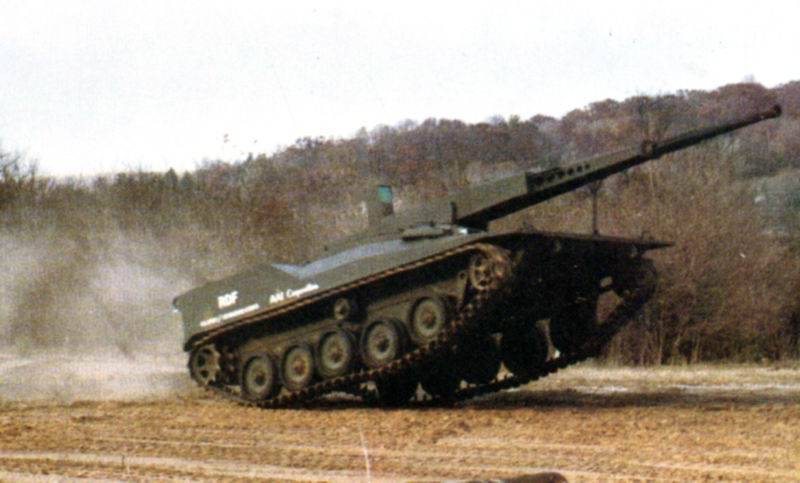
Tank with the last tower during the test. Photo Btvt.narod.ru
An experienced RDF / LT tank was put to the test at the end of the 1980 of the year. For several years, the car worked at the landfills, refined and re-checked. In addition, as new data was collected and experience gained, the combat module was upgraded. Such work continued for several years and ended in the mid-eighties. An analysis of the characteristics and capabilities of the promising machine allowed the customer to make a final decision. With all its advantages, the car did not suit the military. The project has been closed.
The proposed light tank had a number of positive features. First of all, it favorably differed from other armored vehicles with its small size and weight, due to which high strategic mobility was achieved. There were also noticeable advantages in the form of relative ease of production and the possibility of changing the configuration in accordance with customer requirements. All this made it possible to quickly establish a mass production of light tanks and, within a threatened period, quickly transfer a sufficient amount of equipment to the area of possible battles.
In addition, it was possible to obtain high mobility on the battlefield, which can become an additional means of protection and enhancement of general characteristics. In the fighting compartment there was an automatic loader with high characteristics, with the help of which a unique rate of fire was achieved for tanks. In its current form, the RDF / LT machine could be used in various conditions to combat different goals. Due to the high mobility and small size, the tank could show itself well in general combat, attacking armored vehicles and even enemy aircraft. 75-mm high-energy gun could be an effective means of dealing with enemy light and medium-sized machines. Objectives with a higher level of protection, respectively, remained for the main tanks.
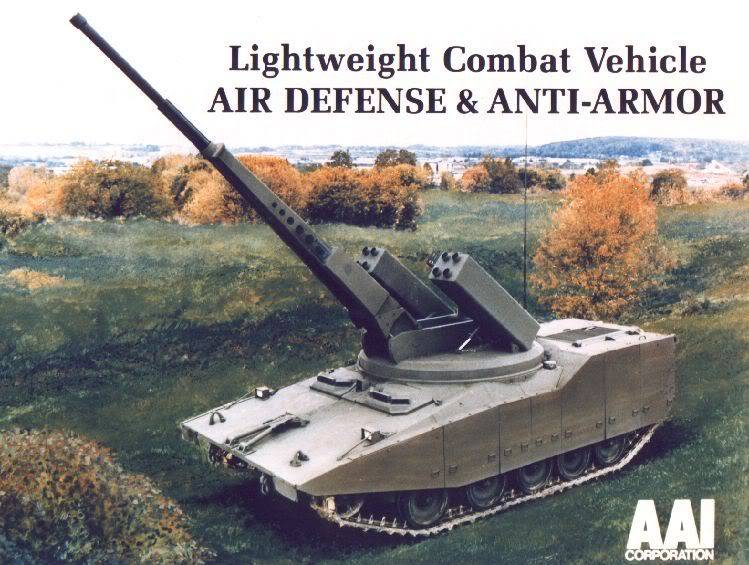
RDF / LT in the version with artillery and rocket armament. Photo by Alternathistory.com
Specific requirements required the use of a number of compromises in the project, which led to the appearance of some ambiguous features and even flaws. First of all, the RDF / LT tank could not be equipped with powerful armor. Combined aluminum-steel armor protected only from small-caliber artillery, which accordingly could affect the survivability of the machine. Another problem could be considered the characteristics of the instrument. The ARES gun had the opportunity to hit modern tanks only in the side or in the rear. In this case, the first response shot could be fatal for a light armored vehicle.
The use of sophisticated automatic loading and modern fire control systems led to a certain increase in the cost of equipment, because of which this parameter went beyond the planned scope. As a result, the program for mass production of armored vehicles could be associated with unacceptably high costs.
From the outset, it was possible to assume that the specific requirements for the RDF / LT project would eventually lead to the emergence of a machine with ambiguous characteristics and capabilities. That is exactly what happened. The company-developer, as a whole, has successfully completed its tasks, but the finished sample could not arrange the customer. As a result, in the mid-eighties, Amia and the Marine Corps decided to abandon the future purchase of light tanks. In the future, it was planned to get along with the available main tanks and other armored vehicles.
Having been refused by the Pentagon, AAI Corporation did not immediately stop work on the project. An attempt was made to offer a light tank to foreign countries. Relevant documents received a number of countries in South America. In addition, some potential customers even got an experienced armored vehicle for their own tests. Nevertheless, even with the help of tests at foreign test sites, the developer failed to find new customers. Soon the RDF / LT project was finally closed due to the lack of real prospects. An experienced armored vehicle, left idle, was sent to conservation.
Light tank AAI RDF / LT added to the list of promising, but did not reach the series of combat vehicles. Already after the project's authors successfully solved all the assigned tasks, the US Department of War realized that the combat vehicle ordered by it had no visible prospects in the context of the modern full-scale armed conflict. The failure of the launch customer and the absence of new potential buyers led to the project stopping. Subsequently, the military-political situation in the world changed and virtually excluded the start of a major war in Europe. As a result, the new armored vehicles, similar to the RDF / LT tank, were no longer needed by the American army.
On the materials of the sites:
http://militaryfactory.com/
http://alternathistory.com/
http://btvt.narod.ru/
http://tankinfo.ru/
http://armyrecognition.com/
http://military-today.com/
Photo review of the prototype in its current state:
http://primeportal.net/tanks/david_lueck/rdf_lt/
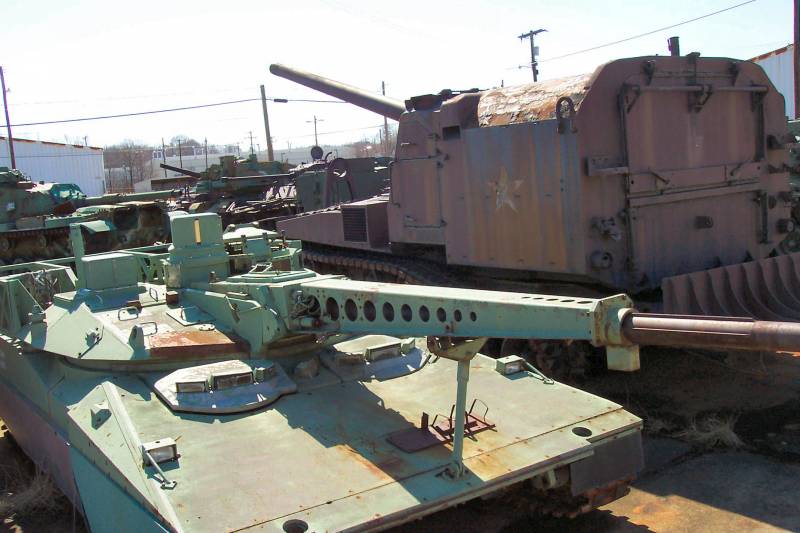
Information